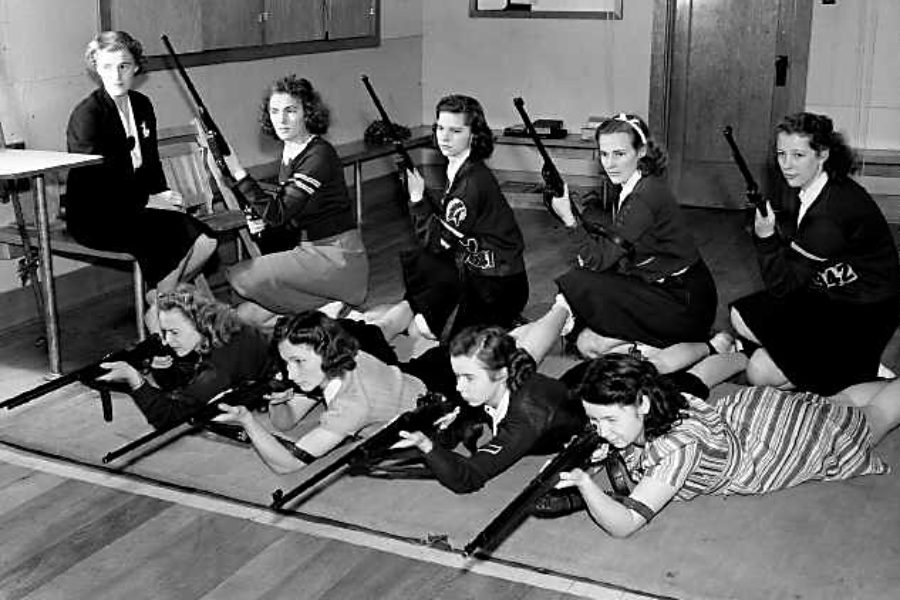In 1953, when I was a nine year old growing up in Georgia, I saw an ad in the back of Popular Mechanics or some similar magazine by Golden State Arms, a mail order firearms dealer in California. It announced the sale of surplus Russian Moisin-Nagant 7.62 mm bolt-action rifles with fifty rounds of ammunition for just $9.99 each.
Wow! The rifle shown in the tiny ad looked cool, and the price was right. So, after robbing my piggy bank and without parental consultation, I sent a postal money order to California and waited.
A month later, a Railway Express driver appeared at our front door with a long narrow box. I hadn’t known that the Moisin-Nagant was over 48 inches long. So I was immediately confronted with a tactical problem. The package was almost longer than I was tall, and it had arrived on a Saturday when my father was home. My hastily improvised plan was to sneak my new rifle into the basement and figure things out from there.
I wrestled the package through the living room and dining room. The door leading to the basement stairs was within reach. The plan was working!
But then, my father appeared out of nowhere and fixed me with a cold gaze.
“Son, what have you got there?”
“Nothing, sir.” For some reason, he didn’t seem convinced.
“Well, then”, he replied, “let’s open up that package and see what nothing looks like.”
Deflated, I watched as he withdrew my new rifle and a flimsy cardboard box containing fifty rounds of ammunition.
Hefting the rifle, he expertly worked the bolt back and forth and pulled the trigger. He wasn’t a big gun owner, but he knew firearms and kept a .22 rifle for home defense.
Then he removed the bolt and handed me the rifle.
“Here you go. Have fun.”
“But, daddy, the gun won’t shoot without the bolt!” I protested.
“My,” he smiled benignly, “you’re such a bright little fellow. Now get along.”
And that was my introduction to gun control.
Even though my Moisin-Nagant never fired a round, there were plenty of other working firearms which were readily available to the boys in our neighborhood. Along with knives, homemade explosives, fireworks, chemistry sets, full contact football without pads, bicycles without helmets, fist fights and so on, we occupied ourselves with daily activities which would today result in our parents’ arrest by the child rearing experts from Children and Youth Services.
Somehow we managed to reach adulthood pretty much unscathed.
As for all those readily available firearms, we used them for plinking, target practice, hunting and competitive shooting. You should know that, in those long ago days, this was considered normal.
In adolescence, some of us joined our high school rifle teams. Boys and girls participated, and the schools provided the guns and ammunition. Also, without school interference, any number of my friends owned revolvers and rapid firing semi-automatic pistols that were kept in their cars or hidden in their book bags. In short, there were numerous firearms on school grounds every day.
And guess what? There were no school shootings. No movie theater massacres. No mass casualties caused by deranged and angry teenagers. But how could this be?
Gun control advocates claim that the difference between then and now is the availability of semi-automatic rifles and handguns with high capacity magazines. While it’s true that AR-15s and Glocks didn’t exist back then, it is equally true that the firearms we had were fully capable of quickly inflicting devastating, large scale death and injury.
Today gun control advocates have arranged to take a group of shell-shocked teenage survivors of the Parkland High School shooting on a road show to the Florida state capital where, according to one young man, “we will plead with the legislators for our lives.” Putting aside the exploitation of these young people, one is moved to ask just what the road show managers and these traumatized children expect the law makers to do.
In stark contrast to the days when a nine year old could buy a firearm through the mail, there exist today layer after layer of laws and regulations restricting the sale and possession of firearms. All of these legislative and administrative measures were putatively enacted to promote public safety by keeping guns out of the wrong hands.
So now that we have gone from a time when the sale and possession of guns were virtually unregulated and there were no school shootings, to a time when such shootings and other random atrocities regularly occur despite the existence of complex legal restrictions on gun ownership, it seems fair to ask a key question. Is more gun control really an answer to the problem?
Contrary to the usual gun control talking points, the basic killing potential of firearms hasn’t changed over the years. For example, in 1966, Charles Whitman, the so-called “Texas Tower Sniper”, used a low capacity bolt action rifle to kill fourteen people and wound thirty-one others before he was killed by the police. This was the first widely publicized mass civilian casualty event and it sent shockwaves throughout the country.
But, despite the tremendous publicity, Whitman’s insane act spawned no copycats. It wasn’t until 1999 that the Columbine High School shooting started the series of regular albeit infrequent school killings.
But why now are children slaughtering other children in our schools?
Could it be the widespread breakdown of the family? A number of the school shooters came from broken homes with no stability or meaningful parenting. Are such children particularly susceptible to being desensitized to death and carnage by the violence-pandering entertainment industry? The amount and graphic nature of violence in homicidal themed video games, movies, television and music lyrics have increased to previously unimaginable levels. While this has resulted in huge profits for the entertainment industry, what is the effect of this new pornography of violence on our children – especially on those without countervailing parental guidance?
And what about the number of children who are being medicated with psychotropic drugs? These medications come with warnings about possible side effects such as suicidal ideation, abnormal urges and depression. Could these very profitable drugs be part of the problem?
What about the publicity given to the shooters? Non-stop coverage of school shootings and their horrendous aftermaths may be good for ratings and circulation, but should the news media be in the business of making a profit by inspiring and motivating potential copycat killers?
The gun control advocates say that enough is enough and that something must be done. I agree. But, given its history of failure, it is apparent that the answer lies not in passing yet another useless restriction on firearms. It is time to face up to the fact that the problem is deep seated, complex and requires a societal examination of conscience.
Thanks to the multi-million dollar entertainment industry, we are marinating our children’s brains in a toxic brew of graphic death and violence. And thanks to the pharmaceutical industry, too many of those children are being inappropriately dosed with drugs that impair their ability to rationally respond to life’s challenges. Both industries control vast fortunes with which they can purchase influence in the halls of Congress and state legislatures. They command battalions of lobbyists and experts who stand ready to defend their interests and to point the finger of blame elsewhere.
All of this raises this question: are our elected representatives willing to pull back the curtain and confront these powerful interests? Will they dare ask the news media, the entertainment industry and the pharmaceutical manufacturers the questions posed here? Will they do so at the risk of losing political and monetary support provided by these interests?
Or will they pursue the politically safer alternative of furthering the demonstrably ineffectual non-solution of more gun control?



2 Comments
Leave your reply.